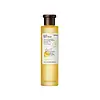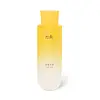What's inside
What's inside
 Key Ingredients
Key Ingredients

 Benefits
Benefits

 Concerns
Concerns

 Ingredients Side-by-side
Ingredients Side-by-side

Citrus Junos Fruit Extract 93%
Skin ConditioningNiacinamide
Smoothing1,2-Hexanediol
Skin ConditioningPPG-13-Decyltetradeceth-24
EmulsifyingPolyglyceryl-10 Laurate
Skin ConditioningSodium Ascorbyl Phosphate
AntioxidantCitrus Aurantium Bergamia Fruit Oil
MaskingCitric Acid
BufferingSodium Citrate
BufferingCitrus Tangerina Peel Oil
MaskingDipotassium Glycyrrhizate
HumectantCaramel
Cosmetic ColorantJuniperus Mexicana Oil
MaskingCaprylic/Capric Triglyceride
MaskingDiacetyl Boldine
Skin ConditioningLimonene
PerfumingLinalool
PerfumingCitrus Junos Fruit Extract 93%, Niacinamide, 1,2-Hexanediol, PPG-13-Decyltetradeceth-24, Polyglyceryl-10 Laurate, Sodium Ascorbyl Phosphate, Citrus Aurantium Bergamia Fruit Oil, Citric Acid, Sodium Citrate, Citrus Tangerina Peel Oil, Dipotassium Glycyrrhizate, Caramel, Juniperus Mexicana Oil, Caprylic/Capric Triglyceride, Diacetyl Boldine, Limonene, Linalool
Water
Skin ConditioningButylene Glycol
HumectantGlycerin
HumectantNiacinamide
Smoothing1,2-Hexanediol
Skin ConditioningDiethoxyethyl Succinate
SolventPPG-13-Decyltetradeceth-24
EmulsifyingMaltodextrin
AbsorbentXanthan Gum
EmulsifyingSodium Citrate
BufferingCitric Acid
BufferingEthylhexylglycerin
Skin ConditioningLimonene
PerfumingAdenosine
Skin ConditioningCitrine Extract
Skin ConditioningCitrus Limon Peel Oil
MaskingDisodium EDTA
Bioflavonoids
Skin Conditioning3-O-Ethyl Ascorbic Acid
Skin ConditioningCitrus Tangerina Extract
TonicLinalool
PerfumingAscorbic Acid
AntioxidantCitrus Limon Peel Extract
EmollientTocopherol
AntioxidantWater, Butylene Glycol, Glycerin, Niacinamide, 1,2-Hexanediol, Diethoxyethyl Succinate, PPG-13-Decyltetradeceth-24, Maltodextrin, Xanthan Gum, Sodium Citrate, Citric Acid, Ethylhexylglycerin, Limonene, Adenosine, Citrine Extract, Citrus Limon Peel Oil, Disodium EDTA, Bioflavonoids, 3-O-Ethyl Ascorbic Acid, Citrus Tangerina Extract, Linalool, Ascorbic Acid, Citrus Limon Peel Extract, Tocopherol
Alternatives
Ingredients Explained
These ingredients are found in both products.
Ingredients higher up in an ingredient list are typically present in a larger amount.
1,2-Hexanediol is a synthetic liquid and another multi-functional powerhouse.
It is a:
- Humectant, drawing moisture into the skin
- Emollient, helping to soften skin
- Solvent, dispersing and stabilizing formulas
- Preservative booster, enhancing the antimicrobial activity of other preservatives
Citric Acid is an alpha hydroxy acid (AHA) naturally found in citrus fruits like oranges, lemons, and limes.
Like other AHAs, citric acid can exfoliate skin by breaking down the bonds that hold dead skin cells together. This helps reveal smoother and brighter skin underneath.
However, this exfoliating effect only happens at high concentrations (20%) which can be hard to find in cosmetic products.
Due to this, citric acid is usually included in small amounts as a pH adjuster. This helps keep products slightly more acidic and compatible with skin's natural pH.
In skincare formulas, citric acid can:
While it can provide some skin benefits, research shows lactic acid and glycolic acid are generally more effective and less irritating exfoliants.
Most citric acid used in skincare today is made by fermenting sugars (usually from molasses). This synthetic version is identical to the natural citrus form but easier to stabilize and use in formulations.
Read more about some other popular AHA's here:
Learn more about Citric AcidLimonene is a fragrance that adds scent and taste to a formulation.
It's found in the peel oil of citrus fruits and other plants such as lavender and eucalyptus. The scent of limonene is generally described as "sweet citrus".
Limonene acts as an antioxidant, meaning it helps neutralize free radicals.
When exposed to air, oxidized limonene may sensitize the skin. Because of this, limonene is often avoided by people with sensitive skin.
The term 'fragrance' is not regulated in many countries. In many cases, it is up to the brand to define this term. For instance, many brands choose to label themselves as "fragrance-free" because they are not using synthetic fragrances. However, their products may still contain ingredients such as essential oils that are considered a fragrance.
Learn more about LimoneneLinalool is a fragrance and helps add scent to products. It's derived from common plants such as cinnamon, mint, citrus, and lavender.
Like Limonene, this ingredient oxidizes when exposed to air. Oxidized linalool can cause allergies and skin sensitivity.
This ingredient has a scent that is floral, spicy tropical, and citrus-like.
Learn more about LinaloolNiacinamide is a multitasking form of vitamin B3 that strengthens the skin barrier, reduces pores and dark spots, regulates oil, and improves signs of aging.
And the best part? It's gentle and well-tolerated by most skin types, including sensitive and reactive skin.
You might have heard of "niacin flush", or the reddening of skin that causes itchiness. Niacinamide has not been found to cause this.
In very rare cases, some individuals may not be able to tolerate niacinamide at all or experience an allergic reaction to it.
If you are experiencing flaking, irritation, and dryness with this ingredient, be sure to double check all your products as this ingredient can be found in all categories of skincare.
When incorporating niacinamide into your routine, look out for concentration amounts. Typically, 5% niacinamide provides benefits such as fading dark spots. However, if you have sensitive skin, it is better to begin with a smaller concentration.
When you apply niacinamide to your skin, your body converts it into nicotinamide adenine dinucleotide (NAD). NAD is an essential coenzyme that is already found in your cells as "fuel" and powers countless biological processes.
In your skin, NAD helps repair cell damage, produce new healthy cells, support collagen production, strengthen the skin barrier, and fight environmental stressors (like UV and pollution).
Our natural NAD levels start to decline with age, leading to slower skin repair, visible aging, and a weaker skin barrier. By providing your skin niacinamide, you're recharging your skin's NAD levels. This leads to stronger, healthier, and younger looking skin.
Another name for vitamin B3 is nicotinamide. This vitamin is water-soluble and our bodies don't store it. We obtain Vitamin B3 from either food or skincare. Meat, fish, wheat, yeast, and leafy greens contain vitamin B3.
The type of niacinamide used in skincare is synthetically created.
Learn more about NiacinamideWe don't have a description for PPG-13-Decyltetradeceth-24 yet.
Sodium Citrate is the sodium salts of citric acid. In skincare, it is used to alter pH levels and acts as a preservative.
Its main functions are to maintain the pH of a product and neutralize metal ions.
The acidity of our skin is maintained by our glands and skin biome; normal pH level of skin is slightly acidic (~4.75-5.5).
Being slightly acidic allows our skin to create an "acid mantle". This acid mantle is a thin barrier that protects our skin from bacteria and contaminants.
Learn more about Sodium Citrate